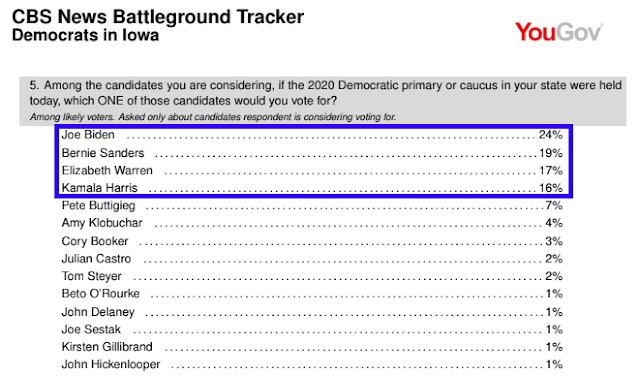Rosselló said in a press release:
“This legislative measure provides the opportunity to put Puerto Rico on the radar of potential presidential candidates in the Democratic Party. The candidates will not only pay attention to Puerto Rico but will have to clearly stipulate their positions regarding the issues that affect the island. In changing the date to the month of March, we can engage candidates directly on the political and economic inequality that Puerto Rico goes through."While the change may increase the odds that more attention is paid to the Puerto Rico primary (and the issues important to island residents), that is not a guarantee on a date that late in March, after Super Tuesday and after more than two-thirds of the Democratic delegates will have been allocated. And any attention gained comes at a cost of the nine bonus delegates the party would have been eligible for in the June position, bonus delegates the party has had over the last several cycles.
--
Notes on that NBC report on the primary date change linked above:
1) It states that Puerto Rico joins California and Texas on Super Tuesday. It does not. The Puerto Rico Democratic primary will fall nearly a month later on the calendar.
2) Let's talk briefly about the date of the Republican presidential primary in Puerto Rico for 2020. The NBC article suggests that the primary for Republicans on the island will occur on March 8. It may. But that is not exactly what the Compulsory Presidential Primary Act that S 1323 just altered for the Democratic Party indicates. It explicitly schedules the Republican presidential primary for the last Sunday in February unless that date conflicts with the New Hampshire primary. The last Sunday in February in 2020 is February 23, a date nearly two weeks after the New Hampshire primary. There is no conflict, not with New Hampshire anyway.
Now, there is a conflict between that last Sunday in February date and Republican National Committee rules prohibiting February primaries and caucuses other than in the four carve-out states. But that particular conflict (and any resulting contingency) is not laid out in the Puerto Rico statute and thus the primary would not be shifted back to the first Sunday in March (which technically would be March 1 and still non-compliant).
The catch in this whole discussion is that it is moot. While there are instructions on when to schedule the Republican presidential primary in the aforementioned statute, the Republican Party in Puerto Rico ignores that in favor of another section of the election code and cited it in their Rule 16(f) filing with the RNC in 2015. That section -- Chapter 407, Section 4119 -- reads:
In the case of primaries for candidates who seek nomination in their political party for election to the office of President of the United States of America, the same may be held on any date after the first Tuesday of February of the General Election year, and up to June fifteenth (15th) of that same year, as determined by the local body of the party, as appropriate.In other words, the statute gives the Republican Party in the territory wide latitude in setting the date of the primary, wide enough to include all of February and the first few days of March that are not compliant under the national party rules. But anything from the first Tuesday in March through June 15 is available to Puerto Rico Republicans. The party may yet settle on March 8 as the article indicates. Alternatively, Republicans on the island could opt to hold their contest on March 29, aligned with the Democratic contest in an effort to cut down on the expenditures for two primary elections. But the point is that it is an open question at this time as to when the Puerto Rico Republican presidential primary will fall in 2020. An answer to that question will become clearer as the October 1 deadline for state parties to submit their delegate selection plans to the RNC.
3) Finally, the California primary was not moved in December of 2018 as mentioned in the NBC piece. The bill moving the primary in the Golden state from the first Tuesday after the first Monday in June to the first Tuesday after the first Monday in March was signed into law in September 2017, well before the end of 2018.
The Puerto Rico Democratic Party primary date change has been added to the 2020 FHQ presidential primary calendar.
--
Follow FHQ on Twitter and Facebook or subscribe for daily updates via Email.










